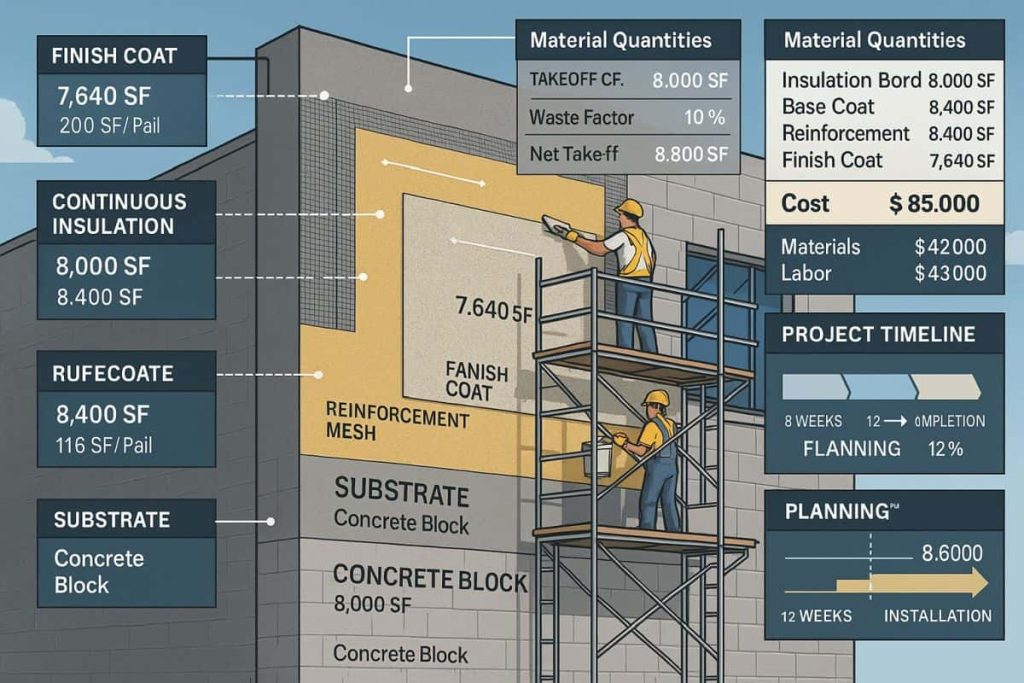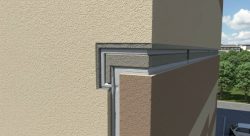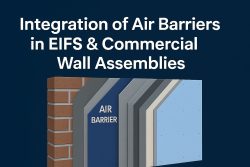Master EIFS Takeoffs with Expert Tips and Proven Accuracy Methods for Large-Scale Exterior Projects
When you’re planning a large Exterior Insulation and Finish System (EIFS) project, getting your material takeoffs right can make or break your budget. After 22 years in the EIFS business, I’ve seen projects succeed brilliantly and others fail spectacularly—often due to poor material quantity calculations.
Whether you’re a contractor bidding on a high-rise façade or a property manager planning a comprehensive exterior renovation, understanding the ins and outs of EIFS takeoff is crucial. Let me walk you through everything you need to know about calculating material takeoffs for large EIFS facades.
Key Takeaways
- Accurate square footage calculations are the foundation of successful EIFS material takeoffs
- Material waste factors typically range from 5-15% depending on project complexity
- Digital quantity survey tools can improve accuracy by up to 30% over manual methods
- Reinforcement mesh weight calculations directly impact both material costs and structural performance
- Proper substrate preparation accounts for 15-20% of total project costs

Understanding EIFS Material Takeoff Fundamentals
Material takeoffs for EIFS projects involve much more than simple square footage calculations. You’re dealing with a complex exterior insulation finishing system that requires precise measurements of multiple components working together.
The basic EIFS system consists of several layers: the insulation board, base coat with embedded reinforcement mesh, and the finish coat. Each layer requires specific materials with different adhesive coverage rates and application techniques.
The Foundation: Accurate Square Footage Calculations
Square footage calculations form the backbone of any EIFS takeoff. But here’s where many estimators go wrong—they treat EIFS like traditional stucco and forget about the unique challenges of exterior insulation systems.
For large EIFS facades, you need to account for:
- Complex architectural designs with multiple planes and angles
- Window and door penetrations that affect continuous insulation layer requirements
- Expansion joint spacing that impacts material layout
- Thermal bridging mitigation requirements around structural elements
Material Waste Factor Considerations
Every experienced estimator knows that material waste factors can significantly impact your final estimate. For EIFS projects, typical waste factors include:
- Insulation material: 5-10% for standard applications, up to 15% for complex geometries
- Base coat and adhesives: 8-12% depending on substrate conditions
- Reinforcement mesh: 10-15% due to overlap requirements and complex details
- Finish coat: 5-8% for standard textures, up to 12% for specialty finishes
🧮 EIFS Material Waste Factor Calculator
5% waste
10% waste
15% waste
Advanced Takeoff Techniques for Large Projects
Computer-Aided Takeoff and BIM Integration
Modern takeoff and estimating services rely heavily on computer-aided takeoff technology. BIM integration allows estimators to extract precise measurements directly from 3D models, reducing human error and improving accuracy.
Digital quantity survey methods provide several advantages:
- Automated square footage calculations from architectural drawings
- 3D visualization of complex building envelope details
- Real-time updates when design changes occur
- Improved collaboration between architects, contractors, and estimators
Shop Drawing Review and Panelization Strategy
For high-rise façade projects, developing a panelization strategy is crucial. This involves breaking down large wall areas into manageable sections that can be prefabricated or installed efficiently.
Shop drawing review helps identify:
- Optimal panel sizes for material selection and installation efficiency
- Connection details between panels and structural elements
- Moisture management strategies for complex assemblies
- Quality assurance checklist items for field verification
Critical Components in EIFS Material Calculations
Insulation Board Specifications
Insulation board selection directly impacts both thermal efficiency and cost per square foot. Common options include:
- Expanded polystyrene (EPS): Most cost-effective, good thermal performance
- Extruded polystyrene (XPS): Higher moisture resistance, premium pricing
- Polyisocyanurate: Superior R-value, ideal for energy-efficient applications
🏗️ EIFS System Component Breakdown
Click on each layer to explore EIFS system components and their specifications
(Sheathing/Block)
(EPS/XPS)
Reinforcement Mesh Weight and Coverage
Reinforcement mesh weight varies significantly based on application requirements:
- Standard mesh: 4-6 oz/sq yd for typical residential applications
- Heavy-duty mesh: 6-10 oz/sq yd for commercial projects and high-impact areas
- Impact-resistant mesh: 10+ oz/sq yd for ground-level installations
Mesh embedment depth requirements also affect material quantities. Proper embedding typically requires 25-50% more base coat than minimum thickness specifications suggest.
Adhesive Coverage Rates and Application Methods
Adhesive coverage rates depend on several factors:
- Substrate conditions and preparation requirements
- Installation method (trowel applied vs. spray applied)
- Weather conditions during application
- Building envelope complexity and accessibility
Typical coverage rates range from 150-250 square feet per bag of adhesive, but this can vary significantly based on substrate preparation needs and trowel techniques.
🎯 EIFS Material Coverage Calculator
Adhesive Coverage
Reinforcement Mesh
Finish Coat
Quick Material Estimator
Project Planning and Cost Management
Budget Development and Cost Estimates
Developing accurate cost estimates requires understanding both material and labor costs. EIFS installation typically involves:
- Substrate preparation: 15-20% of total project cost
- Material costs: 35-45% of total project cost
- Labor costs: 35-45% of total project cost
- Equipment and overhead: 5-10% of total project cost
💰 Typical EIFS Project Cost Breakdown
Project
Costs
📊 Cost Insight: Material and labor typically account for 70-90% of total project costs. Proper substrate preparation is crucial and can significantly impact overall project success.
Material Lead Times and Supply Chain Coordination
Supply chain coordination becomes critical for large projects. Material lead times can vary significantly:
- Standard EIFS components: 2-4 weeks
- Custom colors and textures: 4-8 weeks
- Specialty insulation materials: 6-12 weeks
- Architectural foam shapes: 8-16 weeks for custom designs
Change Order Management and Value Engineering
Change order management requires robust takeoff and estimating procedures. Value engineering options might include:
- Alternative insulation materials for cost-effective solutions
- Modified installation sequences to reduce labor costs
- Simplified details that maintain performance while reducing complexity
- Bulk purchasing strategies for material procurement
Quality Assurance and Performance Verification
Specification Compliance and Building Codes
Specification compliance ensures your EIFS system meets all building codes and performance requirements. Key compliance areas include:
- Fire resistance rating requirements for different building types
- Wind load considerations for high-rise façade applications
- Thermal performance standards for energy efficiency goals
- Moisture management requirements for your climate zone
Safety Factor Calculations and Risk Management
Safety factor calculations should account for:
- Weather impact allowances for seasonal installation challenges
- Site logistics planning for material handling and storage
- Scaffold requirements for high-rise façade access
- Quality control procedures throughout installation
Technology Integration and Workflow Automation
EIFS Estimating Software and Digital Tools
EIFS estimating software has revolutionized the takeoff and estimating process. Modern tools offer:
- Automated material calculations based on system specifications
- Integration with CAD and BIM platforms
- Real-time cost databases for accurate pricing
- Report generation for bid preparation and client presentations
Data Accuracy Verification and Quality Control
Data accuracy verification involves multiple checkpoints:
- Cross-referencing blueprint measurements with field conditions
- Validating material specifications against manufacturer requirements
- Reviewing installation sequences for constructability
- Confirming delivery schedules with project timelines
Sustainable Design and Energy Performance
LEED Certification Credits and Environmental Impact
LEED certification credits can significantly impact material selection:
- Embodied carbon reduction through optimized material choices
- Energy performance improvements from enhanced thermal insulation
- Sustainable construction practices in material sourcing
- Long-term durability considerations for life cycle costing
Energy Efficiency Optimization
Energy efficiency optimization involves balancing thermal performance with cost considerations:
- Continuous insulation layer design to minimize thermal bridging
- Air barrier integration for improved building envelope performance
- Moisture management strategies to maintain insulation effectiveness
- Orientation-specific insulation requirements for optimal performance
Common Challenges and Solutions
Substrate Preparation Variables
Substrate preparation requirements can vary dramatically between projects. Common challenges include:
- Existing wall conditions requiring extensive preparation
- Structural modifications needed for proper installation
- Moisture remediation before EIFS application
- Compatibility issues between old and new materials
Weather-Related Installation Impacts
Weather impact allowances must account for:
- Temperature restrictions for adhesive curing
- Humidity effects on finish coat application
- Wind conditions affecting scaffold requirements
- Seasonal variations in material performance
Cost Analysis and Comparison Data
When evaluating EIFS vs. traditional building materials, consider these typical cost ranges per square foot:
🏠 EIFS vs. Traditional Materials Cost Comparison
| Material System | Cost Range | Energy Performance | Durability Rating |
|---|---|---|---|
| EIFS BEST VALUE | $8-15/sq ft | Excellent | 25-30 years |
| Traditional Stucco | $6-12/sq ft | Good | 20-25 years |
| Brick Veneer | $12-20/sq ft | Fair | 50+ years |
| Fiber Cement | $7-14/sq ft | Good | 25-35 years |
💡 Pro Tip: EIFS offers the best balance of cost, energy efficiency, and performance for most Indiana projects. Contact Indiana Wall Systems for a free estimate!
This comparison shows why EIFS offers an excellent balance of performance and durability for cost-effective exterior finish applications.
Project Timeline and Scheduling Considerations
Feasibility Assessment and Pre-Construction Planning
Feasibility assessment should include:
- Site accessibility for material delivery and equipment
- Existing building conditions and preparation requirements
- Permit requirements and approval timelines
- Seasonal restrictions based on weather conditions
Project Timeline Scheduling
Project timeline scheduling for large EIFS facades typically follows this sequence:
- Design development and specification (2-4 weeks)
- Permit acquisition (4-8 weeks)
- Material procurement (4-12 weeks)
- Substrate preparation (1-3 weeks)
- EIFS installation (4-8 weeks depending on size)
- Final inspection and closeout (1-2 weeks)
📅 EIFS Project Timeline Overview
Working with Professional Estimating Services
Benefits of Professional EIFS Takeoff Services
Professional takeoff and estimating services offer several advantages:
- Experienced estimators familiar with EIFS-specific requirements
- Advanced software tools for accurate calculations
- Industry connections for competitive material pricing
- Risk mitigation through proven methodologies
As Jeff Johnson from Indiana Wall Systems often says, “The difference between a profitable EIFS project and a costly mistake often comes down to the quality of your initial takeoff.”
Contractor Bid Comparison and Selection
Contractor bid comparison should evaluate:
- Material specifications and quality standards
- Installation timeline and project scheduling
- Warranty coverage and long-term support
- References and past performance on similar projects
For residential and commercial projects throughout Indiana, Kentucky, Ohio, Tennessee, Michigan, and Illinois, Indiana Wall Systems has developed proven takeoff methodologies that consistently deliver precise estimates and successful project outcomes.
Advanced Material Selection Considerations
Drainage Plane Design and Moisture Management
Drainage plane design is critical for long-lasting EIFS performance. Water-managed EIFS systems require additional materials:
- Secondary weather barriers behind the insulation
- Drainage channels at horizontal transitions
- Flashing integration at penetrations and terminations
- Vapor barrier considerations for different climate zones
Specialty Components and Architectural Details
Large EIFS facades often require specialty components:
- Architectural foam shapes for decorative elements
- Custom trim pieces for complex transitions
- Expansion joint materials and sealants
- Fire-rated assemblies for specific building requirements
Quality Control and Field Verification
Installation Quality Assurance
Quality assurance during installation involves:
- Material testing and verification upon delivery
- Environmental monitoring during application
- Thickness verification of each system layer
- Visual inspection of finished surfaces
🎯 Professional EIFS Quality Control Checklist
Performance Testing and Validation
Performance testing may include:
- Thermal imaging to verify continuous insulation
- Water testing of completed assemblies
- Air leakage testing of building envelope
- Long-term monitoring of system performance
Regional Considerations for Central Indiana
Climate-Specific Design Requirements
Central Indiana's climate presents unique challenges for EIFS systems:
- Freeze-thaw cycles requiring durable finish coat formulations
- High humidity during summer months affecting curing
- Wind loads from seasonal storms
- Temperature extremes impacting material selection
Local Building Code Requirements
Building codes in Indiana may specify:
- Minimum insulation requirements for energy efficiency
- Fire ratings for different occupancy types
- Structural attachment methods for seismic considerations
- Accessibility requirements for maintenance and inspection
Whether you're planning an EIFS installation in Carmel or a large commercial project in Indianapolis, understanding these regional factors is crucial for accurate takeoffs.
Technology Trends and Future Developments
Automation in Takeoff and Estimating
Estimator workflow automation is advancing rapidly:
- AI-powered quantity surveys from architectural drawings
- Machine learning for improved cost variance analysis
- Real-time material pricing integration
- Automated specification compliance checking
Smart Materials and IoT Integration
Future EIFS technology may include:
- Embedded sensors for performance monitoring
- Self-healing materials for reduced maintenance
- Dynamic insulation systems for optimal energy performance
- Smart coatings that respond to environmental conditions
Cost Optimization Strategies
Material Optimization Techniques
Cost optimization without compromising quality involves:
- Bulk purchasing agreements for large projects
- Alternative supplier evaluation for competitive pricing
- Value engineering of non-critical components
- Waste minimization through improved planning
Labor Efficiency Improvements
Labor efficiency can be improved through:
- Crew training on advanced installation techniques
- Equipment optimization for specific project requirements
- Workflow standardization across multiple projects
- Quality control measures that prevent rework
Frequently Asked Questions
How accurate should my EIFS material takeoff be?
Professional takeoff accuracy should be within 2-5% for material quantities on large projects. This level of precision requires experienced estimators, quality blueprints, and proper data accuracy verification procedures. At Indiana Wall Systems, we use digital quantity survey tools and computer-aided takeoff methods to achieve this accuracy consistently.
What's the typical material waste factor for large EIFS projects?
Material waste factors for large EIFS projects typically range from 5-15% depending on project complexity. Simple rectangular buildings might see 5-8% waste, while projects with complex architectural designs and multiple penetrations could require 10-15% waste allowances. Weather conditions and site accessibility also impact waste rates.
How do I calculate reinforcement mesh requirements?
Reinforcement mesh calculations involve measuring all wall areas plus mesh overlap requirements. Standard overlap is 2.5 inches on all edges, but complex details may require additional reinforcement. Mesh embedment depth affects base coat quantities, typically requiring 25-50% more material than minimum thickness specifications.
What software tools work best for EIFS takeoffs?
EIFS estimating software options include specialized construction estimating platforms with BIM integration capabilities. The best tools offer automated square footage calculations, material waste factor adjustments, and integration with supplier pricing databases. Many contractors also use computer-aided takeoff tools for improved accuracy.
How do building codes affect material calculations?
Building codes significantly impact EIFS takeoff requirements through fire resistance rating specifications, wind load considerations, and thermal performance standards. Code requirements can affect insulation material thickness, reinforcement mesh weight, and attachment methods, all of which impact material quantities and costs.
When should I hire professional estimating services?
Professional takeoff and estimating services become valuable for projects over $100,000 or when dealing with complex architectural designs. Professional estimators bring specialized knowledge of EIFS-specific requirements, access to advanced software tools, and industry relationships that can improve both accuracy and competitive pricing.
Conclusion
Calculating material takeoffs for large EIFS facades requires a combination of technical expertise, advanced tools, and practical experience. From accurate square footage calculations to complex drainage plane design, every detail impacts your project's success.
The key to successful EIFS takeoff lies in understanding that exterior insulation finishing systems involve much more than simple wall measurements. Material waste factors, reinforcement mesh weight, adhesive coverage rates, and substrate preparation requirements all play crucial roles in developing precise estimates.
Whether you're working on residential and commercial projects or tackling high-rise façade installations, investing in proper takeoff and estimating procedures pays dividends throughout the project lifecycle. Quality assurance, specification compliance, and performance verification all depend on accurate initial calculations.
For property owners and contractors throughout central Indiana, professional EIFS services can make the difference between a successful project and costly surprises. With 22 years of experience and 160 years of combined expertise, Indiana Wall Systems has developed proven methodologies that consistently deliver accurate takeoffs and exceptional results.
Ready to ensure your next EIFS project starts with accurate material calculations? Contact Indiana Wall Systems at (765) 341-6020 for a comprehensive consultation and precise estimate for your exterior insulation needs.
Looking for more EIFS expertise? Explore our comprehensive guide to EIFS installation best practices or learn about choosing the perfect EIFS system for your project.




